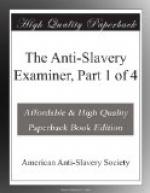Here is a charter for slaveholding, under the sign manual of that “good old slaveholder and patriarch, Isaac.” Yea, more—a “Divine Warrant” for a father holding his children as slaves and bequeathing them as property to his heirs! Better still, it proves that the favorite practice amongst our slaveholders of bequeathing their colored children to those of a different hue, was a “Divine institution,” for Isaac “gave” Esau, who was “red all over,” to Jacob, “as a servant.” Now gentlemen, “honor to whom honor.” Let Isaac no longer be stinted of the glory that is his due as the great prototype of that “peculiar domestic institution,” of which you are eminent patrons, that nice discrimination, by which a father, in his will, makes part of his children property, and the rest, their proprietors, whenever the propriety of such a disposition is indicated, as in the case of Jacob and Esau, by the decisive tokens of COLOR and HAIR, (for, to show that Esau was Jacob’s rightful property after he was “given to him” by Isaac “for a servant,” the difference in hair as well as color, is expressly stated by inspiration!)
One prominent feature of patriarchal example has been quite overlooked by slaveholders. We mean the special care of Isaac to inform Jacob that those “given to him as servants” were “HIS BRETHREN,” (twice repeated.) The deep veneration of slaveholders for every thing patriarchal, clears them from all suspicion of designedly neglecting this authoritative precedent, and their admirable zeal to perpetuate patriarchal fashions, proves this seeming neglect, a mere oversight: and is an all-sufficient guarantee that henceforward they will religiously illustrate in their own practice, the beauty of this hitherto neglected patriarchal usage. True, it would be an odd codicil to a will, for a slaveholder, after bequeathing to some of his children, all his slaves, to add a supplement, informing them that such and such and such of them were their brothers and sisters. Doubtless it would be at first a sore trial also, but what pious slaveholder would not be sustained under it by the reflection that he was humbly following in the footsteps of his illustrious patriarchal predecessors!
Great reformers must make great sacrifices, and if the world is to be brought back to the purity of patriarchal times, upon whom will the ends of the earth come, to whom will all trembling hearts and failing eyes spontaneously turn as leaders to conduct the forlorn hope through the wilderness to that promised land, if not to slaveholders, those disinterested pioneers whose self-denying labors have founded far and wide the “patriarchal institution” of concubinage, and through evil report and good report, have faithfully stamped their own image and superscription, in variegated hues, upon the faces of a swarming progeny from generation to generation. ]




